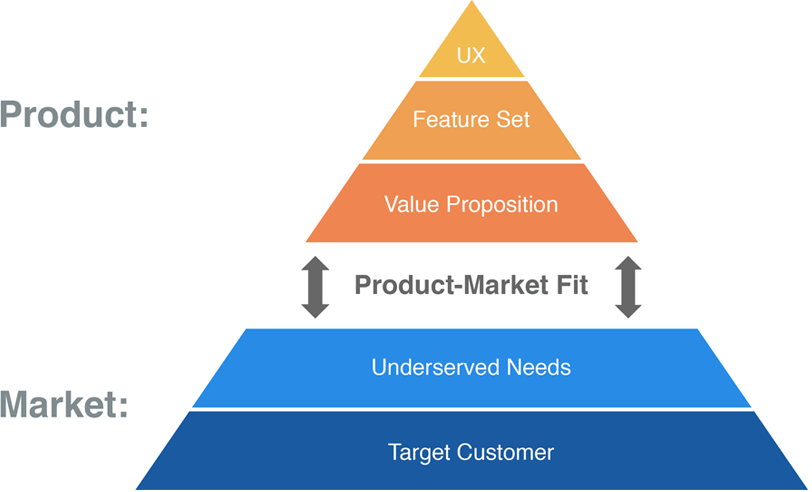Building a company is hard.
One of the hardest things is that at the very beginning you don't know if you are on the right track.
It is easy to fall in love with your idea and to jump to building a product no one is willing to pay for.
Or to tirelessly look for reassurance in research and discovery work and fail to take the risks and the decisions that will bring the team forward.
It is even easier to leave the bus too early, meaning you abandon an opportunity too quickly.
If you fail, you will likely say you did because there was no product-market fit (PMF). In this guide, I explore what this means.
This is a six part series where I dive deep into PMF.
Part 1 (this piece) is about the definition of PMF.
Part 2 is the place where we dive into what you can do to find it.
Part 3 is about how do you know you have it a.k.a how to measure and engine your way towards it.
Part 4 deals with the most common criticisms against it.
Part 5 is a bonus with the best ressources I gathered during my own learning experience.
What is product-market fit?
The only thing that matters is getting to product/market fit. (…) When you get right down to it, you can ignore almost everything else.
PMF refers to the degree to which a product satisfies the needs of a particular market and audience.
In a nutshell, it is about is how well your product is received and used by a group of people.
If you cracked it, it means you understand who uses your product or service and how your product delivers valuable to these people.
PMF is this milestone that if achieved, will enormously increase your chances of success as it is the right point to start focusing on growth.
To grasp better what it means, lets break it down to both its components: the product and the market.
Breaking down Product-Market fit to its components
For this break down I rely on the Product-Market Fit Pyramid framework by Dan Olsen.

Two things stand out of this representation:
Firstly, a product is a tangible set of features that together deliver value for your market.
You have PMF when this set of features meets enough target customers with underserved needs (this is also what - Marc Andreessen calls "being in a good market").
Secondly, the representation as a pyramid.
A pyramid only stands firm if the basis holds. Or, the higher levels depend on the lower levels. In this case, bother about a solution (a.k.a a product) only after you figured out your market.
This means that, if when confronting reality you realise you’d be better off by changing your customer, you need to start over again. If you realise there are no underserved needs that your product is solving, you need to start over again. Higher levels are dependent on lower levels.
Like every pyramid, start at the bottom: with the market.
Market
A market is a group of buyers (people) that share some underserved needs and the willingness to pay for something to solve that need.
As a product manager you do not control the market. You can only pick it.
When doing so, pick wisely. Consider not only the size of the market but also your ability to reach the market (channel) and your overall ability to generate leads.
Invest early in learning how to get in touch with the customers, where they hang out, where they spend their time, which media they consume, which groups or associations they belong to. The survival of your business depends on it. Don’t wait till you finish your product to go and find it.
In my experience, how much you struggle already finding your target customers to get in touch and learn about them in the very early pre-product stages is a proxy of how difficult your sale efforts will be.
The target customer needs to be tangible and clearly definable: for example it is very different to target customers directly (D2C) than to target business for example (B2B). And if targeting customer directly, it is very different if you want to target GenZ youngsters or already retired customers. If you target GenZ youngsters, it is different if you are targeting the urban elite in high income places or if you are aiming for a more rural population.
Once you picked your market, it is about understanding their needs: Who am I trying to serve? Whose life am I trying to improve? What are their pains? Go out and find them. Speak to them, get to know them. Put yourself out there until you can put yourself in their shoes. And by this I mean you know the brand of shoes they like, where did they buy it and which perfume they are wearing. Develop your empathy muscle.
Product:
The product is the upper layer of the pyramid and is the part of the pyramid that you control because you can chose the promise you want to make to your target customers.
The product layer has three components:
Value proposition. in simple words is the promise you make to your customers about the way you will serve them.
Feature set. What is the functionality we need to build to deliver that promise.
UX Design. This your unique way of implementing or bringing this functionality alive. It can be in the form of a prototype, an MVP, or a new feature.
In the Dan Olsen model PMF is:
How well the assumptions, decisions and execution in the top three product layers resonate with the realities of the market you operate in.

